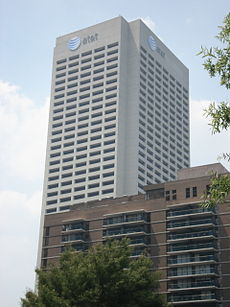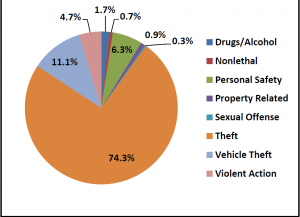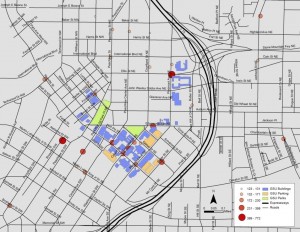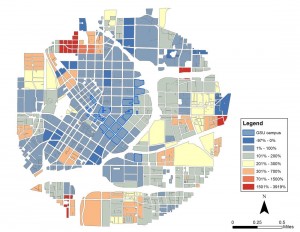My parents choose to move to Johns Creek, Georgia because they heard it had excellent schools. They associated the quality of the town with the quality of the school. At the lower education level, good schools are synonymous with good neighborhoods. When it comes to higher education, however, the relationship between a school and its city is much more complicated. Such is the case with Georgia State University, located in the heart of Atlanta, Georgia. I will examine the relationship between Georgia State University (GSU) and the city of Atlanta through two major factors: the municipal economy and crime. Overall, Georgia State has had a positive effect on the city of Atlanta through the reduction of crime and the expansion of the municipal economy.
A Brief History of GSU’s Expansion

Courtesy of Georgia State University
First, we can examine the nature of Georgia State’s development since its inception as the Georgia School of Technology’s (now commonly referred to as Georgia Tech) Evening School of Commerce in 1913. Holding classes in rented space in downtown Atlanta, the School moved its location several times to surroundings that could accommodate the increasing enrollment. Wayne S. Kell, a member of Georgia Tech’s administrative staff, directed the school during its early years. In 1947, after Georgia Tech and the University of Georgia became incorporated into the University System of Georgia under the Georgia Board of Regents, the Regents decided that the Georgia Tech Evening School of Commerce should be an independent college. In 1947 it was incorporated by the Board of Regents into the program of the University of Georgia. At that time the institution became the “Atlanta Division of the University of Georgia.” By 1955 the Board of Regents came to realize that the Atlanta Division was acquiring a destiny and a unique identity of its own, and proceeded to establish the college as its own university. You can find more on Georgia State’s history here.

Courtesy of Georgia State Univesity
More recently, GSU has been expanding and integrating into the fabric of Atlanta more rapidly than ever. Over the past 15 years, downtown Atlanta has witnessed substantial changes as GSU expands its footprint with former GSU President Carl V. Patton’s Main Street Master Plan. With the Main Street Master Plan, introduced in 1997, GSU hopes to increase student residency and enrollment at its downtown campus while expanding its properties in the downtown area. The Master Plan has already seen major construction projects including dormitories, dining halls, recreational facilities, classrooms, labs, parking decks and a state-of-the-art science center constructed in just the last 15 years. The Turner Field purchase is just one of the many major projects GSU hopes to complete in the foreseeable future. GSU has had an instantly recognizable role in physically shaping downtown Atlanta. Along with its physical expansion, however, we see that GSU is shaping broader, less visible factors within downtown Atlanta.
Georgia State’s Impact on Atlanta Crime
One of these major factors is crime. Atlanta benefits from Georgia State’s integration into the city in many ways, but one explicit benefit is crime reduction. My parents’ number one concern with me
going to Georgia State and living downtown was safety. Over the past few years, news media havereported numerous stories about student safety at Georgia State University. These newscasts influence the public’s perception of GSU and the city. Naturally, it is within Georgia State’s best interest to make sure that students feel safe on campus and that parents feel safe sending their children to school in a large urban environment.Therefore, Atlanta’s crime issues become Georgia State’s as well. Georgia State police work extensively with Atlanta police in order to reduce crime in downtown Atlanta.
Hot-spot crime analysis hopes to identify the areas around campus that experience the highest crime rates. The areas are referred to as “hot-spots.” Steven Ericson conducted a study in 2014 using hot-spot analysis data to find where the most repeat crime offenses occur within the city and on campus. Of the top one percent of the 3,333 locations analyzed, 33 addresses in the study area are represented. Fourteen of these 33 addresses are GSU properties and account for 3,258 of the 7,464 crime events reported. Three of the GSU locations were residence halls: University Commons, University Lofts, and Piedmont North. In addition to residence halls, other high-density crime locations on GSU property were community gathering places like the Student Center, Library North, and the Student Recreation Center.

Courtesy of Georgia State University
Hot-spot analytics has had the strongest evidence that it decreases crime. Community oriented policing conducted with the partnership of Atlanta’s police department and GSU police is an effective strategy to reduce crime in Atlanta. The interaction between students and faculty, Atlanta police, and GSU police has created a “multi-pronged” approach that has and will continue to decrease crime rates in Atlanta (Ericson).
How Georgia State Influences the Local Economy
Georgia State has had a substantial influence on Atlanta’s economy. The urban research institution attracts companies to the city, its students inject a considerable amount of capital into the municipal economy each year, and property values in the city have risen along with the university’s expansion.

Tech Square, Atlanta Georgia. Courtesy of The Georgia Institue Of Technology
Businesses are relocating to Atlanta at startling rates to be near some of the large urban research Universities here, mainly Georgia Tech and Georgia State. Over the last decade, Tech Square, the eight square block area in Midtown designed for the use of large research companies and Georgia Tech students, has seen 12 Fortune 500 corporate research centers relocate to it. These companies, including big names such as AT&T, Panasonic, and Coca-Cola, along with smaller technology startups are just a few examples of the growing trend of businesses relocating to be near urban universities.

AT&T Headquarters in Atlanta
What’s driving this trend of companies moving to be near urban universities is the changing landscape of partnership within the private sector. Private companies are becoming increasingly aware of the external sources of support they gain from these universities. In the past, large technologically focused companies tended to isolate themselves from others because they had more or less of a monopoly on the market in which they focused. (Andes, et al.) In 1960 for example, DuPont was the leading polymer company in the world. DuPont greatly innovated in polymer science, inventing essential materials such as nylon and Kevlar we now use daily. All of this was done, however, from its closed off research campus in Wilmington, Delaware. Businesses of the time sought to create new markets where these futuristic technologies had not yet existed. (Andes, et al.) In the 21st century, few companies can still monopolize the technology they rely upon to effectively work. There is also a lot more rapid competition among these companies. Consider the tablet computer, the first iteration of which to be widely used by mainstream consumers was released by Apple in 2010 in the form of the iPad. The next year at the Consumer Electronics Show, almost a dozen competing tablet computers were on display. Today, companies aren’t as focused on making fundamental research technology as they are on “leveraging” it (Andes, et al.) from universities and learning from other firms and researchers located in dense, urban cities such as Atlanta.
When corporations relocate, most of the time it’s towards cities home to leading research universities that incentivize student engagement in the private sector. Such universities including Georgia Tech and Georgia State in Atlanta, MIT in Cambridge, and Washington University in St. Louis have all seen corporate research centers move to the outskirts of their campuses not only because they are located in cities, but also because universities encourage students and faculty to work with these businesses. GSU and Georgia Tech reward postgraduates for patenting their work, working with small businesses, and they implore faculty to seek federal grants supporting research projects with the help of the private sector. (Andes, et al.)
Especially in a city like Atlanta, where businesses of all kinds are relocating, there is no shortage of job opportunities for students graduating from these areas. And businesses are looking for just these types of workers. At Georgia State, I rarely find a time when there aren’t hundreds of flyers for job fairs and internship seminars taking place on campus, rife with businesses and organizations looking for young, intellectual students that the urban research institution provides.
The increased number of residence halls on campus has brought more and more of these students into the city. Since 2002, new residence halls have brought almost 4,000 students within walking distance of the campus’ core. These students spend money both on and off campus, funneling capital into the municipal economy. According to 2011-12 academic year data, GSU had a total of 32,022 students enrolled. According to their estimates, a GSU resident spends $3,384 in the city, a commuter student living at home spends $5,974, and a commuter not living at home spends $13,774 in the city. While we can’t assume all of this was spent exclusively in downtown Atlanta, it’s fair to say that a large portion of it was. Based on data from GSU, Ericson was able to calculate that no less than $10 million enters downtown Atlanta’s economy from GSU’s student population each year. And as GSU continues to expand and bring more residents and commuters to downtown Atlanta each year, this number is sure to increase.
Property values have risen in downtown Atlanta along with GSU’s expansion as well. Steven Ericson, a GSU graduate, conducted a study to assess whether GSU’s campus expansion has increased surrounding property values in 2014. He obtained shape files from the Fulton County Board of Assessors for all of the properties in Fulton County on an annual basis from 2000 to 2012.
He narrowed the data down to focus on properties within a one-mile radius of Dahlberg Hall, one of the core buildings on GSU’s campus. Using this data, Ericson measured the change in property values during GSU’s expansion. He found that land near the university has increased in value since 2000. The increases ranged from 1 to 100 percent, so it’s hard to say the extent to which GSU has had a hand in increasing these values, but it has had an influence nevertheless. From 2007 to 2012, properties bordering the downtown campus have increased more substantially.During this period, GSU opened its residence halls University Commons and Piedmont North in 2007 and
2008 respectively. These halls brought nearly 3000 students to downtown Atlanta. Data shows that by this point, 93 percent of the properties bordering GSU’a Atlanta campus have increased in value. Georgia State plays a significant role in maintaining and furthering downtown Atlanta’s economic vitality.
The relationship between Georgia State and Atlanta is complicated. While it is by no means completely positive or negative, GSU has had a positive influence on the city in many ways. As the university expands even more in the coming years (Turner Field purchase etc.), it is important to keep the relationship between the campus and the city in mind.
Works Cited
Andes, Scott, and Bruce J. Katz. “Why Today’s Corporate Research Centers Need to Be in Cities.” Harvard Business Review, March 1, 2016.
Ericson, Steven. “THE IMPACT OF AN URBAN UNIVERSITY AND ITS NEIGHBORHOOD: A CASE STUDY OF GEORGIA STATE UNIVERSITY AND DOWNTOWN ATLANTA.” Accessed November 4, 2016.
H.M. Cauley. “How Georgia State is reshaping downtown Atlanta ” Atlanta Business Chronicle. N.p., n.d. Web. 09 Dec. 2016
“Special Collections and Archives: Georgia State University History: Brief History; Admin. Org” Research Guides. N.p., n.d. Web. 09 Dec. 2016 <http://research.library.gsu.edu/c.php?g=115683&p=754351>.





